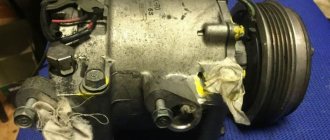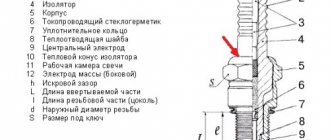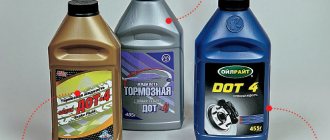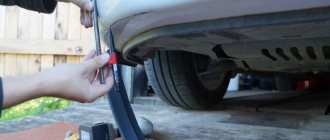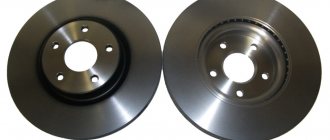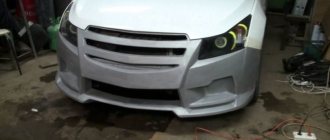Published:
09.03.2016
Many modern cars do not have the gear shift mechanism that is familiar to us all. This function is transferred to small handles that peek out from behind the steering wheel. They have a slightly strange name that not every driver understands: “steering wheel shift paddles.” This innovation is worth studying in detail, since an increasing number of automakers are equipping their new products with this element.
Using the steering wheel paddles, you can change gear without taking your hand off the wheel
Steering wheel shift paddles: what they are and how to use them
In some new cars, instead of the usual lever, you can see paddle shifters, which are used to change gears. They are small handles conveniently located under the steering wheel.
Most often, such innovation can be found in sports high-speed cars. The Ferrari concern was a pioneer in modernizing this system - the paddle shifters under the steering wheel provided the driver with an advantage, since he did not have to take his attention from the steering wheel to change the speed.
How do paddle shifters work?
The paddle shifters are designed for an electronic transmission, so they can be placed wherever it is convenient for you, but manufacturers by default put them under the steering wheel, believing that this is the optimal place.
When you pull back on the handle, the electronics send a signal to the transmission inductor and the gear shifts. This system is provided in cars with two clutches. You can dispense with the paddles if you are uncomfortable and use the usual automation - the machine itself turns them off when they are not used for a long time in the control.
How to use petals
Many drivers who have changed their car to a more modern version do not know how to use the paddles correctly and simply turn off the manual mode, returning to automatic. Each car has its own handling nuances, but the basic principles are the same.
How to use standard paddle shifters:
- When the paddle is pulled down, the car prepares for climbing or braking on sharp descents. To increase the speed, you need to press the “+” lever located on the right, to decrease the speed – “-” located on the left. Pay attention to the control panel screen - the current gear is displayed there.
- Move the paddle down or up and the gears will gradually change through the full range.
- Press and hold "+" to switch the system from manual to automatic control - in this case the paddles are not used.
- Press the gas pedal so that the automation itself selects and sets the optimal speed.
- To change to another gear, bypassing the previous ones (for example, from 2 to 4), press “+” or “-” twice, wait a few seconds and press the desired lever again.
From second gear, you can select any speed without touching the clutch, but only by pressing the paddles. They may not respond to requests in several cases:
- While holding the steering wheel, you use two paddles at once with random presses, and the speed does not change to the set one.
- You are trying to reduce (increase) the speed until the motor reaches the desired threshold.
- You hold the lever and simultaneously press the other.
- Failure in the system - in this case, the corresponding letter appears on the control panel screen (depending on the car model), and the car returns to the automatic transmission.
Now it is generally clear what the steering wheel paddle shifters are for and how to use them. But each car brand has its own characteristics that are worth learning about before getting behind the wheel and driving a long distance.
The advantages of paddle control include convenience and safety, ease of changing speed. Cars with such a system are easily mastered by beginners in driving.
As for the disadvantages, the main one is the price. Also, experienced drivers do not like the fact that a software robot does everything for them - the paddle shifters only create the illusion of independent control, which is very different from a real manual transmission and, even more so, from a manual transmission. Many people like to drive their own car rather than rely on automation.
Sequential gearbox: design, advantages and myths
In our review of the most dynamic road car from Lotus, presented at the end of June 2015 at Goodwood, you might have noticed the presence of a sequential gearbox, which has long been an integral attribute of sports and supercars.
Since some Karakum residents are interested in the structure and features of this type of gearbox, I will tell you about it. Sequential gearbox
differs in the ability to only sequentially switch between gears.
In other words, the driver can move only one gear higher or lower than the one in use, without jumping through the rest, as can be done in a classic manual transmission with a search shift principle.
I propose to get acquainted with this type of gearbox in more detail and dispel a couple of misconceptions associated with sequential gearboxes.
Operating principle of a sequential gearbox
As we have already found out, the gears of this type of transmission are switched only one by one, in a strictly specified sequence. And since the sequential gearbox is built on the basis of a manual gearbox, we will make references based on the principle of operation specifically to the manual gearbox.
Firstly
, the sequential gearbox is characterized by the absence of a clutch pedal, which will primarily please less experienced drivers. This makes driving a car much easier, because constantly dancing with your left foot on the clutch pedal, frankly speaking, is not an acquired taste.
The clutch is controlled not by the driver, but by an electronic unit that receives a signal from sensors that read the press on the gas pedal and directly engage a specific gear. As they say, it's a matter of technique.
When the box receives a command from the electronic unit, a new signal about the used vehicle speed is transmitted to the progressive unit using special sensors. The progressive block is the last resort where the speed limit is adjusted based on various indicators: from engine speed to air conditioning operation.
Video demonstrating the operation of a sequential gearbox. How quickly the speeds change!
Secondly
, the sequential gearbox uses spur gears. They produce a higher efficiency when compared with helical gears from a manual transmission. This is because helical gears have more friction losses.
But spur gears are also capable of transmitting less torque, so sequential gearboxes often use larger gears to compensate for this disadvantage.
And finally, the third distinctive feature
A sequential transmission is the presence of hydraulic servos, with the help of which the gears are switched.
Nowadays, hydraulic servos are often associated with robotic gearboxes, but this is not the case. The latter uses electric ones. Evgeniy Travnikov talks about one of the options for the sequential gearbox in his video:
Advantages and disadvantages of the sequential gearbox
Now that we have an idea of the operating principle of the mentioned transmission, let's figure out what to expect from it. Advantages:
1. High speed and ease of switching
between gears.
Thanks to the presence of an electronic control unit and a hydraulic mechanism, switching times are reduced to 150 milliseconds, which plays a significant role in professional motorsport.
None of the classic transmissions, both mechanical and automatic, can boast of faster gear shifting.
In addition, with a sequential gearbox, you will not frantically try to get to the desired speed, rushing with all your horsepower around the ring, when high load and shaking with vibration prevents you from keeping the car on the correct trajectory.
2. There is no loss of speed when switching.
3. Economical fuel consumption.
The last two points are rather a consequence of the first, but we cannot help but take this into account, giving credit to the sequential checkpoint.
4. Possibility of switching using steering wheel paddles.
Yes, this technology, so loved by real racers, was discovered thanks to the sequential shift mechanism.
Like an element from a spaceship - petals behind the wheel of a car
Many modern cars do not have the gear shift mechanism that is familiar to us all. This function is transferred to small handles that peek out from behind the steering wheel. They have a slightly strange name that not every driver understands: “steering wheel shift paddles.” This innovation is worth studying in detail, since an increasing number of automakers are equipping their new products with this element.
Using the steering wheel paddles, you can change gear without taking your hand off the wheel
How did these strange devices appear?
Many innovations that drivers successfully use have emerged thanks to sports competitions involving sports cars. The same thing happened with the new mechanisms for high-speed shifting, located near the steering wheel. For the first time, steering wheel shift paddles appeared on models of the Italian manufacturer Ferrari. Thanks to these devices, racers received an important advantage over other competitors - the ability to not take their hands off the steering wheel to change gears. All their attention was focused on the road, which increased the chances of winning and increased safety for the driver. Since that time, not only racing drivers began to use steering column systems, but also ordinary drivers received this opportunity by purchasing production models from the modern automobile industry.
This mechanism is presented in the form of a pair of small plastic levers that are located behind the steering wheel. Their use is convenient not only for the driver, but also for the passenger sitting in front.
Operating principle and process of use
When the user presses the paddle, a signal is transmitted to the control system installed in the gearbox. The electronic unit activates the automatic transmission solenoids, resulting in a change in the gear ratio. Automation activates the required gear. There are no drives connected to the petals, since the electronics are responsible for everything. This feature allows you not to be limited in choosing a place to install the petals, but still the most successful and optimal in many respects is the steering column area.
Modern gearboxes with only two clutches can boast of a similar mechanism. Traditional automatic transmissions are equipped with such a system less often. If the steering column transmission control system is not used for a long time, the automatic system turns it off and activates the normal mode for controlling the transmission.
The paddle shifters are plastic levers
The ease of use of the paddle shifter is most felt during active driving. For example, the driver needs to overtake. This maneuver will require a sharp increase in speed. The automatic gear shift mode will work in its usual mode, and the use of the paddles will allow you to increase engine speed and change gears at the maximum power levels of the power unit. This control reduces the likelihood of accidents during overtaking, which often happen with cars with automatic transmission.
Device
In essence, the paddle shifters are a pair of plastic levers that, when pressed, change gears. They are located under the steering wheel, which is extremely convenient not only for the driver, but also for the passenger in the front seat.
Plastic levers
The convenience of such gear shift paddles is especially felt during active driving, for example, when you need to increase speed while overtaking. In this case, the automation will begin to change speeds in normal mode, and the use of steering wheel paddles will make it possible to spin the engine, changing gears at the limit of its power to increase acceleration. Considering how often accidents occur during overtaking, such paddles are a good help for the driver.
Advantages and disadvantages of petals
With a paddle shift mechanism, the driver can not be distracted from driving the vehicle and does not have to take his hand off the steering wheel to make maneuvers on the road. This is the main advantage that experts and users of cars with petals highlight. In addition, they look great and transform the interior of the car.
Unfortunately, there are also disadvantages. It's worth starting with the high cost, which can be a strong argument for refusing to buy a car. The user of a vehicle with a paddle mechanism will have to completely entrust the control process to computer systems. And not every driver likes this.
Innovation makes our lives more convenient and safer. They do not need to be rejected or shunned. If you can afford to buy a car with steering wheel paddle shifters to control the transmission, then do just that.
What are gearbox paddle shifters used for?
The paddle shifters, responsible for selecting the gearbox gear, were previously used exclusively in high-performance racing cars, allowing the driver to keep his hands on the wheel and improve acceleration dynamics for precious fractions of a second. But times have changed and today similar technical solutions are already available on the new Ford Escape and even the Honda Odyssey minivan.
Design features and scope of application
The idea itself of moving the automatic transmission shift lever to the steering column is not at all new; since the middle of the last century in the USA, the vast majority of cars have been equipped with just such a mechanism. So paddle shifters are just a logical development of the design in accordance with modern realities.
In most cases, this innovative approach does not find sufficient support in the form of consumer demand, because people are not willing to change their own habits. The fact is that on a subconscious level, questions arise, first of all, about the reliability of the design, as well as the possibility of using traditional turn signals and the risk of touching the gear shift lever.
“In any case, a certain percentage of buyers will want to buy a car with this design,” says Erich Heuschle, an engineer at Fiat Chrysler Automobiles. He works on FCA's SRT racing brand with the people responsible for creating cars like the 707-horsepower Dodge Challenger SRT Hellcat. Heuschle is also one of FCA's elite group of engineers, which was created to test designed vehicles to their limits. That is, he has the right to make his proposals to the design until it meets his high requirements. “Transmission paddles are now perceived more as a luxury or driving feature rather than a high-performance design, all thanks to the refinement of how the automatic operates,” he said. “We put a lot of effort into ensuring that the automation functions perfectly.”
In most cars, such switches are used to facilitate the control process and quickly select the desired gear. As a rule, the lever on the right side of the steering wheel is used to change to an upshift, and on the left - to a downshift. Cars equipped with an automatic transmission may have other methods of shifting, for example using buttons on the selector, or switching to manual mode and selecting a gear using a lever.
“You can use paddle shifters in conjunction with cruise control to keep the engine at a specific rpm range,” Heuschle explained, adding that performance may be the most popular reason for using such a mechanism. It is worth noting that he has extensive experience in designing sports cars, so the technical side of the issue is rather determined by the desire to realize the full potential of the car being created.
He said that in automatic mode, the eight-speed ZF automatic transmission found in the Challenger SRT Hellcat is capable of shifts in just 160 milliseconds, which is quite fast and can even rival some dual-clutch cars, which are often cited as the fastest vehicles on sale. .
For reference, the Bugatti Veyron can move from a standstill in 8 ms, while the Nissan GTR does it in 150 ms. But sport and the desire for record performance are not the only areas of application for steering wheel-mounted gearbox controls.
In fact, Heuschle explained that most of the statistics SRT cites in its releases are achieved with the car in automatic mode. “I want shifters to be completely unnecessary,” he said, explaining that manual shifting may not be the most efficient for such cars. “On the tracks where we test our products, this is an unnecessary feature. But again, not all roads are like our model test sites, which results in the continued need to use manual switches.”
He also explained that at the race strip, where the SRT Hellcat is the leader in most metrics, automatic mode is the fastest method of getting to the finish line. The Hellcat accelerates from zero to 60 mph in the middle of its third-gear operating range. And the National Hot Rod Association (NHRA) has documented an official quarter-mile time of 11.2 seconds with civilian tires or 10.8 seconds with low-rolling-resistance radials. "The Hellcat is NHRA-certified operating exclusively in automatic mode." Heuschle said.
Gear shift lever - studying the design and problems + video
Sometimes a motorist is faced with the question of why the gear shift lever dangles, but before answering it, you should clearly understand what this gearbox element is, its structure and what functions it performs.
A feature of all manual gearboxes is the need to manually operate the lever. We can assume that it is precisely this that performs the most important function in determining the speed limit of your movement.
This means that without it, driving a vehicle becomes simply impossible.
The principle of operation of the lever is quite simple: by tilting it in the longitudinal and transverse directions, you set it to a position that corresponds to a certain speed.
The gear shift lever handle is connected to the synchronizer via a fork, the position of which transmits information about the number of the selected speed.
The synchronizer sets the gears of the gearbox so that the generated engine power allows the car to move at a given speed.
When the position of the lever corresponds to neutral gear, it is held in place by springs. The gear shift pattern is often depicted on the head of the lever.
How can the gear shift lever be positioned?
The location of the gearbox levers can be either floor-mounted or steering column mounted. And despite the fact that the latter is considered more convenient to use, nevertheless, in most cases, car manufacturers prefer the first option.
This is due to some disadvantages of the steering column arrangement, including: low speed and clarity, the likelihood of incomplete gear engagement, the rods wear out much faster, sometimes they can jam, as well as “knocking out” the gear.
But in both cases, the design of the gear shift lever remains the same.
The only differences can be in length, and if previously it could reach even 30 cm, today manufacturers strive to make it as small as possible, eliminating too much travel of the gear lever.
Therefore, with a floor arrangement, nothing will change significantly in the design, but there will be noticeably fewer breakdowns.
Shift lever squeak and other problems
From all of the above, it is clear that this part is one of the most important in the entire gearbox, and if it fails, then driving such a vehicle becomes life-threatening.
The most common reasons why such an emergency can occur are either mechanical damage or the consequences of incorrect operation.
Here are a few breakdowns that you can easily detect on your own.
You should know that the gear shift knob should move freely, without jamming .
If difficulties arise in performing this action, most likely the spherical washer or ball joint has failed. They need to be replaced urgently. The creaking of the gear shift lever also indicates a malfunction.
If spontaneous shutdown occurs, then you should definitely check the spring; it is quite possible that it simply jumped off.
Manual mode as an objective necessity
If we abstract from the issues of accelerating dynamics and increasing productivity, then there is a more practical application for the design of steering column switches. Truck expert Stephen Elmer commented: “When towing a heavy trailer, especially on long inclines or descents, it may be necessary to make shifts, but it is advisable to keep your hands on the steering wheel to maintain control of the vehicle.”
When driving SUVs or crossovers equipped with paddle shifters, such as the Jeep Grand Cherokee or Subaru Outback, drivers can use the quick shift paddles when approaching a hill to maintain constant acceleration. The opposite is also true: they can manually brake the car when going downhill or approaching a traffic jam. Automation cannot see hills and analyze the upcoming situation, so changing gears in anticipation of an ascent or descent will allow you to use the vehicle's resources more efficiently.
Heuschle explains that engine braking, which is only possible in manual mode, will not damage the expensive transmission. “We are ready, according to customer needs, to equip vehicles with such switches,” he said. “At the same time, the automatic system will not allow you to downshift when the engine speed is close to maximum.” He added that SRT and ZF carry out a lot of testing to ensure that the transmissions can cope with the rigors of everyday use.
“Endurance tests are carried out manually, which allows us to guarantee a high service life of components and assemblies.” The designer explained how these tests are carried out and what loads the most critical elements are subjected to. “We do 50 runs of the strip with the hardest tires and then 50 with the low rolling resistance radials, both teams driving as aggressively as possible.”
It is worth noting that until recently, paddle shifters were the prerogative of automatic transmissions, but this year Master Shift designers presented their development in the field of manual transmissions to the general public. In the car, the clutch pedal is retained, but the stage selection is controlled by electrified steering column switches.
Another example of the feasibility of automating the gear shift process is driving on a snowy road. Most automatics will allow the car to start in second gear rather than first, which will limit the amount of torque sent to the drive wheels and also help prevent wheels from spinning or losing traction in the snow.
Most cars can be equipped with a trail mode that automatically does the same thing, but paddle shifters put the driver in control. According to Heischle, switches are “when you want to be in control of a situation. Driving a car is a labor-intensive process, automation of which allows you to achieve the best results, however, the current level of technology does not yet allow us to fully anticipate all possible situations.” And these situations are usually related to driver preferences.
So, if you are not satisfied with the performance of the automatic transmission, do everything yourself, do not be afraid to take control.
Steering wheel shift paddles
Today, most ordinary low-budget cars seen on city roads are equipped with a conventional gearbox. But as soon as you sit behind the wheel of one of the expensive cars, you will immediately notice the rather unusual small handles sticking out behind the steering wheel. These are the steering wheel gear shift paddles. True, they are located not under the steering wheel, but directly behind it.
Today we will tell you about what paddle shifters are for, when they were first installed on production cars, all the advantages and disadvantages, as well as how to use paddle shifters.
The history of the appearance of steering wheel paddles
If you know anything about cars, then you should be well aware that most of the usual safety and driving comfort systems were born in the world of motorsports. It's the same story with the steering wheel paddle shifters.
They were first used back in the eighties of the last century on Formula cars. Their appearance was due to the replacement of conventional gearboxes with electromechanical gearboxes. Thus, it was necessary to come up with an option that would allow changing gears in a completely different, fundamentally new way. It was required that the rider could change gears while riding without taking his hands off the steering wheel. This was also a safety issue, since the incredible speeds of the Formula require maximum driver concentration on the track.
Ferrari pioneered the use of paddle shifters. They quickly realized that petals could give their riders a distinct advantage while still providing maximum safety. However, it took other teams only a few months to realize the same thing. At the moment, all cars are not only equipped with paddles at the request of the racers and designers themselves, but are simply required to use them according to the regulations. As you understand, after such innovations in racing, paddle shifters for shifting gears very quickly migrated to ordinary production cars.
Americans have created paddle shifters for manual transmissions - DRIVE
Interestingly, to connect the steering wheel paddles to the “brains” of the system, it is not necessary to run new wires inside the steering shaft. The petals are connected to an existing wire in the steering wheel - from an audio signal, through which commands are transmitted digitally.
In Las Vegas, at the SEMA show, Master Shift presented an entertaining kit that allows you to convert the manual six-speed transmission on the two-door Corvette C6 into a partially robotic transmission with electronic paddle shifters. In this case, the car remains with three pedals, but loses the usual mechanical lever. The driver is invited to switch gears by lightly pressing the steering column switches.
The company has several options for paddles suitable for installation under different steering wheels, and several actuators adapted to a wide variety of manual transmissions. So it’s not just the Corvette that can be remade in this way.
The system operates on a preselective principle. The drive unit is connected to the box through adapters. It can change gears in the same way as if the driver were moving a regular lever.
A sensor is mounted under the traditional clutch pedal that determines the moment the discs open. When the driver selects a new gear by clicking the paddle, the electronics wait for the conventional clutch to open, which is done the old fashioned way - by pressing the pedal with the foot.
At this moment, the servo drive closes the desired stage, and then the person himself closes the clutch discs again.
The actuator on the box shifts gears in 0.25–0.3 s - faster than the average driver would shift it manually. The gearbox essentially remains a “mechanics”, but now you don’t need to take your hands off the steering wheel.
If you click the left or right petal two or three times at once, then at the moment the disks open, the box will move, respectively, two or three steps up or down. But at the same time, there is protection against accidental shifting of the gearbox to neutral or unintentional engagement of reverse gear - for this you need to press separate safety buttons.
Also, the electronics will refuse to engage reverse even at the driver’s command if the car is rolling forward faster than 1.6 km/h. Finally, as an option, the company is ready to supplement its system with a floor-mounted electronic lever, with which you can duplicate the commands of the steering wheel paddles, changing gears by briefly moving the handle forward or backward.
Share
Share
Like
How to use the paddle shifters?
In order to understand how to use the petals, you will have to understand how they generally work.
The entire process is initiated by pressing the steering wheel paddle, which signals the system's control unit that you are changing gear. The automation immediately sets the requested gear. Thus, the petal itself has no connection with the gearbox, that is, it is not directly connected to it in any way. Everything is controlled directly by an electronic program. You can most often find petals on relatively new gearboxes that have two clutches. Traditional automatic transmissions cannot always be combined effectively with a paddle shift system.
It should be noted that there are several options for switching to manual mode using the petals. It all depends on the make of the car and the manufacturer of the system. So, sometimes it’s enough just to press the paddle to immediately change gear. There are models that require the driver to separately select manual mode using the dashboard, after which it becomes possible to use the steering wheel paddle shifters.
Steering wheel paddle shifters for manual transmission
Until recently, paddle shifters were only installed on automatic transmissions. But the designers of Master Shift from the United States demonstrated an innovative and quite promising concept in this direction at the auto show in Las Vegas. Their invention makes it possible to replace a manual transmission with a system with steering wheel paddle shifters. Three pedals remain in the car, but the traditional manual transmission stick is not used. The drive unit and the box are connected via adapters. Under the clutch pedal there is a special sensor that detects the release of the discs, and then using the paddle, the required gear is selected. After depressing the clutch pedal, the discs are separated, the electric drive supplies the required stage and the discs are closed.
The designers installed special systems that block the electric drive when selecting reverse speed if the car is moving forward.
It is likely that in the near future cars equipped with such a gear shift system will be mass-produced.
Loading …
Steering wheel shift paddles - a necessity or just another toy?
Imagine that you have spent your entire life driving the steering wheels of budget cars, and changing gears using a traditional manual gearbox. And suddenly you find yourself in the driver's seat of a modern premium car. The first thing you will see in front of you is a steering wheel covered in expensive leather, behind which strange handles will stick out. These are nothing more than steering wheel gear shift paddles. Although they are called steering column paddles, they are actually located directly behind the steering wheel, not under it.
These devices are designed to simplify the process of driving a car.
So what are these petals for? When did they first appear on cars? What pros and cons do they have?
New toy - steering wheel paddle shifters. Or is it still a necessity?
Just imagine, you have always driven ordinary, not too expensive passenger cars. Everything is standard, gears change as usual. Nothing new.
And suddenly a fairy flew in, waved her magic wand and you already see yourself sitting in the driver’s seat of a fancy, cool, premium car! The first thing that appears before your eyes is the steering wheel. And what do you see? There are strange handles sticking out from behind the steering wheel.
This is not the mistake of a crazy designer, but those same paddle shifters. Before you take a ride in a luxury car, it would be good to figure out what kind of petals these are.
A little history
So, it was in the late 80s of the last century. Conventional manual transmissions of Formula 1 cars began to be replaced with others - electromechanical ones. Innovation. Formula 1 received a second wind, because now it was possible to switch without taking your hands off the wheel. For Formula racing cars, this decision was akin to doping. After all, you can’t be distracted for a second on this track.
Ferrari became a pioneer in installing such mechanisms, which was received with a bang. Petals have become a part of the lives of racers.
How it works?
When you press such a paddle, a signal is sent to the control unit of the box and the desired gear is switched on automatically. Everything is done electronically, without wires. This is very convenient, but not very common.
On some gearboxes, the paddle shifters work as soon as you press them, while on others, control is possible only after you select manual mode to change gears.
About the fly in the ointment
First, once again about honey, that is, about the advantages. Of course, the best thing here is that the driver doesn’t even have to take his hand off the steering wheel when overtaking, when he needs to quickly switch gears. Not everyone on the road is proficient in manual control, and paddle shifters are a wonderful panacea for them.
And in the end, it's beautiful. It's stylish. The salon looks modern and attractive.
Now about the proverbial fly in the ointment... If you are one of those drivers who would not like to completely trust the electronics, but also to participate to a large extent in the process, then you may not like it.
Whatever one may say, time moves forward and technologies become more and more automatic. Everything is done to increase comfort and ease of life. For the drivers described above it will be like..
well, what a pleasure it is to chop wood yourself when there are a bunch of alternatives created to make your work easier in every possible way.
Another indisputable disadvantage is that it is expensive. This means maintenance, but if you have already afforded such a luxurious car, then it is unlikely that this will be so important to you. Although, all millionaires are different.
We wish you joy from communicating with innovations and do not forget the good old manual control!
Source: https://bilety-pdd.com/blog/sovety-avtolyubitelyam/podrulevye-lepestki/
History of origin
Like many technical solutions familiar to us today, steering wheel shift paddles were born in the world of motorsport. Towards the end of the 80s of the last century, new electromechanical gearboxes began to be installed in Formula 1 cars, instead of the usual mechanical ones. And this allowed manufacturers to use a fundamentally new way of changing gears. Namely, without taking your hands off the steering wheel. After all, in the world of Royal Racing there are such speeds at which you cannot take your eyes off the road even for a second. Otherwise, the racer risks ending up outside the track, stuck in a concrete wall.
The first team to introduce steering column mechanisms was the Italian Ferrari. Having assessed the advantages and safety of the new technical solution, other teams also equipped their cars with similar devices. Since then, Formula 1 drivers have used paddle shifters exclusively.
How do the gear shift paddles work?
Pressing the paddle transmits a signal to the gearbox control unit, after which the automation selects the gear you need. Thus, no switching drives are connected directly to the paddles; everything is controlled electronically. Most often, modern dual-clutch transmissions are equipped with a similar mechanism; paddle shifters are less common on traditional automatic transmissions.
Video about how they work:
Activating the manual shift mode in automatic transmissions occurs in different ways. On some, you just need to immediately press the paddle to change gear. In others, you must first select manual gear changing mode and only after that you will be able to use the paddles.
Principle of operation
During squeezing, a signal is transmitted from the lever to the electronic unit, which activates the automatic transmission solenoids, and the gear ratio changes. The driver of the car can only select the moment of switching, and the computer, using electric drives, will automatically switch on the desired speed. The fact that the drives are not directly connected to the steering column paddles makes it possible to place them anywhere, but the most suitable one is still the steering column paddle. There are alternatives to this design. For example, on the Mazda sixth series, the steering column is equipped not only with a pair of paddles, but also with speed reduction levers on both sides. This is done so that the driver of the car can increase and decrease the speed with one hand.
Activation of manual control in various designs can occur either by simply pressing the petals, or by selecting this mode on the main selector. If the paddles are not used for a long time, special systems will automatically switch the transmission to normal control mode.
Pros and cons of steering wheel gear shift paddles
Perhaps the biggest advantage of using paddle shifters is that the driver does not have to take his hand off the wheel to quickly downshift when overtaking. Unfortunately, not all modern drivers have the necessary level of skill to control both the situation on the road and the process of changing gear manually. And taking into account the fact that cars are becoming more powerful and faster, paddle shifters are becoming a real panacea for such unfortunate drivers.
Another plus is that such systems look great. They actually make the car's interior visually more attractive and modern. Some of the paddles look like spaceship controls.
And now about the cons. They are most noticeable to those drivers who like to participate in the process of driving, rather than trusting the computer to do all the work. For such people, switching with a traditional stick is a special ritual, an integral part of all driving. And the trouble is that many car manufacturers today are no longer equipping their models with conventional mechanics, increasingly giving preference to automatic transmissions with the option of manual gear shifting. But nothing can replace the pleasure of competently shifting the throttle on the approach to the next turn and clearly resetting the gear...
Of the minuses, it is also worth noting the high cost of servicing boxes with manual switching modes. However, if you can afford a car worth several million rubles, you are unlikely to care about such trifles. But for those who are used to counting money, this will be a powerful argument.
Steering wheel paddle shifters
Paddle shifters are another way to change gearbox speeds.
History of appearance
The idea to place gear shift levers on the steering wheel of a production car came from motorsport.
In the late 80s of the last century, Formula 1 racing cars began to be equipped with electromechanical gear shift systems. The first formula team to release a car with petals from the paddock was Ferrari.
Petals have since found their way into racing car designs. Over time, they appeared on civilian cars.
The spread of petals was preceded by the appearance of a Tiptronic type system.
This additional automatic transmission option allows the driver to change the gear ratios as desired. The driver selects the switching moment, and Tiptronic handles the implementation.
The selector of automatic transmissions equipped with Tiptronic has an additional track where you can move the lever, thereby activating manual gear shifting. Such boxes appeared in 1990 on the 911 Porsche model.
Design and principle of operation
Essentially, these paddles are two plastic levers that you can press to change gears. They are located on the steering column, which is very convenient for both the driver and the passenger.
The benefits of the paddle shifters can also be felt during dynamic driving, for example when you need to accelerate to overtake. In this case, the automatic transmission will change gears as usual, and the use of the paddles will allow you to spin the engine, changing gears at the peak of its power, which will increase the intensity of acceleration.
Considering how often accidents occur when overtaking, the paddle shifters really seem like a breath of fresh air for the motorist.
Pressing the lever transmits a signal to the control unit, which activates the automatic transmission solenoids and the gear ratio changes.
The driver selects only the moment of shifting, and the process of changing gears is carried out by electric drives under computer control.
The absence of drives directly to the paddles allows you to place them anywhere, but the most convenient location is the steering column.
There are variations of such systems:
Mazda 6 Series cars are equipped with a steering wheel not only with two paddle shifters, but also with downshift levers on each side. This is done so that the driver can both upshift and downshift using only one hand.
Activation of the manual switching mode in different designs can be done by pressing the petals, or by selecting this mode on the main selector. If the paddle shifters are not used by the driver for a certain time, then some systems can automatically switch the box to automatic shift mode.
Steering wheel paddle shifters for manual transmission
Until recently, when you mentioned paddle shifters on the steering wheel, you didn’t have to think about what type of gearbox you were talking about. However, engineers from the American company Master Shift changed the rules of the game.
At the SEMA tuning show in Las Vegas in 2012, a system was presented that allows you to replace a manual transmission with a transmission with electronic paddle shifters. In this case, the car remains with three pedals, but the usual manual transmission lever is not used.
The essence of the invention is that the drive unit is connected to the box through adapters. A sensor is installed under the clutch pedal that records the moment the clutch discs open.
By clicking the paddle, the desired gear is selected, then the electronics waits for the clutch to be pressed, and as soon as the discs are disconnected, the electric drive brings the desired gear and the driver closes the discs, releasing the pedal.
The developers have provided special systems that block the electric drive when selecting reverse gear when moving forward at a speed of over 1.6 km/h.
It is quite possible that cars with a similar gear shift system will soon go into mass production.

